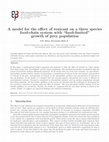Volume 1 Issue 2 by Raveendra Babu. A

In this paper, a mathematical model is proposed and analyzed to study the effect of toxicant in a... more In this paper, a mathematical model is proposed and analyzed to study the effect of toxicant in a three species
food chain system with “food-limited” growth of prey population. The mathematical model is formulated using the
system of non-linear ordinary differential equations. In the model, there are seven state variables, viz, prey density,
intermediate predator density, density of top predator, concentration of toxicant in the environment, concentration
of toxicant in the prey, concentration of toxicant in the intermediate predator and concentration of toxicant in
the top predator. In the model, it is assumed that the carrying capacity and growth rate of prey is affected by
environmental toxicant. Toxicant is transferred to intermediate predator and top predator populations through
food chain pathways. All the feasible equilibria of the system are obtained and the conditions are determined for
the survival or extinction of species under the effect of toxicant. The local and global stability analysis of all the
feasible equilibria are carried out. Further, the results are compared with the case when toxicant is absent in the
system. Finally, we support our analytical findings with numerical simulations.
The modeling investigation in this paper discusses the system level effects of a toxicant on a th... more The modeling investigation in this paper discusses the system level effects of a toxicant on a three species food chain system and the state variables of the models are prey and predator densities, concentration of toxicant in the environment and the concentration of toxicant in the prey population. In the models, we have assumed that the presence of top predator reduces the predatory ability of the intermediate predator. The stability analysis of the models is carried out and the sufficient conditions for the existence and extinction of the populations under the stress of toxicant are obtained. Further, it is also found that the predation rate of the intermediate predator is a bifurcating parameter and Hopf-bifurcation occurs at some critical value of this parameter. Finally, numerical simulation is carried out to support the analytical results.









Uploads
Volume 1 Issue 2 by Raveendra Babu. A
food chain system with “food-limited” growth of prey population. The mathematical model is formulated using the
system of non-linear ordinary differential equations. In the model, there are seven state variables, viz, prey density,
intermediate predator density, density of top predator, concentration of toxicant in the environment, concentration
of toxicant in the prey, concentration of toxicant in the intermediate predator and concentration of toxicant in
the top predator. In the model, it is assumed that the carrying capacity and growth rate of prey is affected by
environmental toxicant. Toxicant is transferred to intermediate predator and top predator populations through
food chain pathways. All the feasible equilibria of the system are obtained and the conditions are determined for
the survival or extinction of species under the effect of toxicant. The local and global stability analysis of all the
feasible equilibria are carried out. Further, the results are compared with the case when toxicant is absent in the
system. Finally, we support our analytical findings with numerical simulations.
food chain system with “food-limited” growth of prey population. The mathematical model is formulated using the
system of non-linear ordinary differential equations. In the model, there are seven state variables, viz, prey density,
intermediate predator density, density of top predator, concentration of toxicant in the environment, concentration
of toxicant in the prey, concentration of toxicant in the intermediate predator and concentration of toxicant in
the top predator. In the model, it is assumed that the carrying capacity and growth rate of prey is affected by
environmental toxicant. Toxicant is transferred to intermediate predator and top predator populations through
food chain pathways. All the feasible equilibria of the system are obtained and the conditions are determined for
the survival or extinction of species under the effect of toxicant. The local and global stability analysis of all the
feasible equilibria are carried out. Further, the results are compared with the case when toxicant is absent in the
system. Finally, we support our analytical findings with numerical simulations.